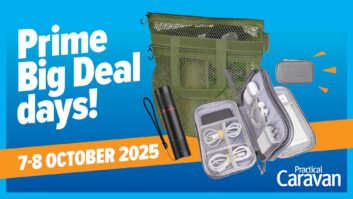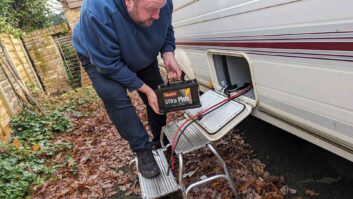If you’re setting off for a snowy escape in Switzerland or just enjoying the charming chill of winter in the UK, you’re probably beginning to plan how to stay cosy while in your caravan.
If you’re storing a caravan over winter, there will obviously be different considerations, but there are plenty of easy changes you can make to continue enjoying life on the road well into the winter season. If you do brave the elements, towing a caravan in winter isn’t hugely different from other times of the year but there are things to consider, including tyre health, road conditions and whether caravan covers are a good idea for you.
Caravanning in winter can be pretty magic once you’re on the road, allowing you to enjoy the crisp air, quiet campsites, and stunning frosty landscapes. However, staying warm is essential to fully enjoy a trip like this.
Here, we look at some achievable – and affordable – changes you can make to your van and your kit collection in order to stay cosy and comfortable.
Practical Caravan is supported by its audience. When you purchase through links on our site, we may earn an affiliate commission. Learn more
How to keep a caravan warm in winter:
Insulate your caravan
Have an efficient heating system
Eliminate moisture
Layer up
Choose the right campsite
Insulate your caravan
Proper insulation is crucial for retaining heat inside your caravan. Many modern caravans are equipped with pretty solid insulation, but you can choose to enhance it with foam boards, fibreglass, foil or even wool. There are also tweaks to be made in the caravan itself which can make a lot of difference:
Thermal curtains or blinds
This is an affordable and relatively easy remedy for a chilly caravan. Investing in some good sets of thermal window coverings can massively reduce heat loss through your windows. Depending on your window specs, there are plenty of ready-to-hang options, like these fully lined Trend curtains, or you could buy thermal lining and cut to size, to add to your existing furnishings.
Draft excluders
You may have spent ages weighing up the best caravan awning to enjoy summer evenings, but did you know you also invested in a great draught excluder? Attaching one to your front door creates an airlock of sorts, helping retain warm air when coming in and out or removing muddy boots before entering your caravan. To keep your awning and caravan even cosier, try a caravan skirt which can act as a great draft excluder and wind break.
Seal joints around windows, doors and skylights with weather-proof tape, weather stripping or caulking to eliminate any draughts.
Insulated flooring
Another budget friendly way to keep a caravan warm is adding rugs and carpets. These can provide extra insulation beneath your feet, as well as a touch of comfort and style. Natural fibres like wool are even better at trapping heat so will offer more cosiness.
Have an efficient heating system
Most caravans, especially modern models, will come with efficient heating systems as standard, with the biggest UK manufacturers being Truma and Whale who offer blown-air and wet radiator heating systems (although the latter tends to appear in luxury caravans).
Check out John Sootheran’s comprehensive guide to understanding caravan heating systems if you want to know more
Having an effective heating system is essential in winter and may be the most important consideration but an ancillary heater can make a lot of difference. There are a few things to think about when choosing the best caravan heater for your needs, including the power you’ll require and what kind of fuel is best:
Ceramic and fan heaters provide instant warmth. Fan heaters blow warm air immediately but can be noisy, whereas ceramic heaters are quieter and safer, as they distribute heat evenly without overheating small spaces.
Plug-socket heaters are the most space-saving option. These compact units plug directly into a socket but generate less heat due to their size.
Oil-filled heaters are a safer choice, as they don’t overheat wires or have open flames. Though slower to warm up than fan heaters, they retain heat more efficiently.
Oil-free heaters are the safest electric option for caravans. With no risk of oil leaks and an aluminium heating system, they provide silent operation which is ideal for nighttime use.
Eliminate moisture
Combatting condensation
With efficient heating and cold weather comes the dreaded condensation problem, which can lead to mould as well as making your caravan feel damp and chilly, especially in the mornings.
To tackle this, we recommend finding the best caravan dehumidifier for the size of your caravan, which could include our personal favourite, the X. Wipe down windows and walls regularly to remove condensation, or invest in a condensation vacuum to stay on top of it with ease. It’s also helpful to keep a moisture meter on hand, too – take a look at our guide to what a moisture meter is if you’re not sure exactly what it will do.
Ventilate properly
It goes without saying that however you choose to keep your caravan warm, all ventilation points should remain open and unobstructed. You can also fend off mold by opening windows to allow some airflow into your van and prevent buildup.
Layer up
No, I’m not going to tell you to pack a coat (although that is always good advice!), but the way that you pack your caravan can help prevent unnecessary drafts. If you fill your lockers and storage spaces up, it will eliminate space for cold spots and act as a kind of makeshift insulation.
Having said that, a good pair of fleece-lined slippers or a blanket for lounging can make a world of difference. I love the wearable blankets which are great for pottering about in the van or popping to the facilities.
Use an electric blanket or a hot water bottle for extra warmth in bed. If you’re in particularly cold areas, think about investing in a four-season sleeping bag. Although you may have good caravan bedding, an extra bit of warmth is always welcome on very cold nights, plus these can also be unzipped and used as a blanket.
Choose the right campsite
Picking the best caravan park to stay at is the best bit of trip planning, whatever the season. If you’re touring in less-than-ideal weather, consider a sheltered location to protect against strong winds and opt for campsites with heated facilities for added comfort. It’s also worth checking the site’s electricity capacity and any restrictions to ensure you can run heating appliances effectively.
Final thoughts
With the right insulation, heating, and moisture control, you can stay warm and comfortable throughout any winter caravanning trip. Small adjustments, from thermal curtains to strategic layering, make a big difference in keeping the cold at bay. Whether you’re embarking on a short getaway or a longer winter adventure, a well-prepared caravan ensures a cosy and enjoyable journey. For even more tips and tricks, check out our comprehensive guide to the winter season!
Future Publishing Limited, the publisher of Practical Motorhome, provides the information in this article in good faith and makes no representation as to its completeness or accuracy. Individuals carrying out the instructions do so at their own risk and must exercise their independent judgement in determining the appropriateness of the advice to their circumstances. Individuals should take appropriate safety precautions and be aware of the risk of electrocution when dealing with electrical products. To the fullest extent permitted by law, neither Future nor its employees or agents shall have any liability in connection with the use of this information. Double check any warranty is not affected before proceeding.
If you’ve enjoyed reading our guides, why not get the latest news, reviews and features delivered direct to your door or inbox every month. Take advantage of our brilliant Practical Caravan magazine SUBSCRIBERS’ OFFER and SIGN UP TO OUR NEWSLETTER for regular weekly updates on all things caravan related.








